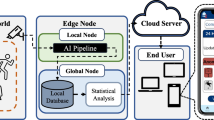Abstract
The Video Event Awareness Workbench (VEAW) analyzes surveillance video from thousands of video cameras and automatically detects complex events in near-real-time-at pace with their input video streams. For events of interest to security personnel, VEAW generates and routes alerts and related video evidence to subscribing security personnel. Complex event processing in VEAW is driven by user-authored awareness specifications comprised of inter-connected spatio-temporal stream and statistical operators that consume and produce events described in VEAW’s surveillance ontology. In this paper we introduce VEAW’s event driven architecture and describe its solutions for automating video surveillance, including the orchestration of continuous and tasked video analysis algorithms (e.g., for entity tracking and identification), fusion of events from multiple sources in an installation-specific “world” model, and proactive information gathering to deal with missing or incomplete information (this is done by tasking video analysis algorithms and security personnel to provide it). We also discuss how VEAW deals with late arriving information (due to out-of-band video analysis tasks and overhead), as well as a related resource optimization aimed at minimizing computation costs. We illustrate the benefits of VEAW by illustrating its application on the automation of real-world security policies.
Similar content being viewed by others
Explore related subjects
Discover the latest articles, news and stories from top researchers in related subjects.References
Abadi, D.J., Carney, D., Çetintemel, U., Cherniack, M., Convey, C., Lee, S., Stonebraker, M., Tatbul, N., Zdonik, S.: Aurora: a new model and architecture for data stream management. VLDB J. 12(2), (2003)
Abadi, D.J., Ahmad, Y., Balazinska, M., Çetintemel, U., Cherniack, M., Hwang, J.-H., Lindner, W., Maskey, A., Rasin, A., Ryvkina, E., Tatbul, N., Xing, Y., Zdonik, S.: The design of the borealis stream processing engine. In: Second Biennial Conference on Innovative Data Systems Research (DR 2005) (2005)
Arasu, A., Widom, J.: Resource sharing in continuous sliding-window aggregates. In: VLDB 2004, (2004)
Aref, W., Catlin, A.C., Elmagarmid, A., Fan, J., Guo, J., Hammad, M., Ilyas, I., Marzouk, M., Prabhakar, S., Rezgui, A., Teoh, S., Terzi, E., Tu, Y., Vakali, A., Zhu, X.: A distributed server for continuous media. In: 18th International Conference on Data Engineering (ICDE’02), 2002
Baker, D., Cassandra, A., Rashid, M.: CEDMOS: Complex event detection and monitoring system. MCC Technical Report CEDMOS-002-99. Retrieved 2005 from http://citeseer.ist.psu.edu/baker99cedmos.html (1999)
Baker, D., Georgakopoulos, D., Schuster, H., Cichocki, A.: Customized process and situation awareness. Int. J. Coop. Inf. Syst. 11(3, 4), (2002) (World Scientific)
Borealis Project: Borealis second generation stream processing engine. Retrieved 2005 from http://nms.lcs.mit.edu/projects/borealis/
Chakravarthy, S.: Snoop: an expressive event specification language for active databases. IEEE Data Knowl. Eng. 14(10), (1994)
Georgakopoulos, D., Baker, D.: Providing physical security via video event awareness. In: Int. Conf. on Signal Processing and Multimedia Applications (SIGMAP), (2006)
Georgakopoulos, D., Schuster, H., Baker, D., Cichocki, A.: Managing escalation of collaboration processes in crisis mitigation situations. In: 16th International Conference on Data Engineering (ICDE’00) (2000)
GVI: GVI TRAK. Retrieved 2006 from http://www.samsung-security.com/
Hongeng, S., Nevatia, R., Bremond, F.: Video-based event recognition: activity representation and probabilistic recognition methods. Comput. Vis. Image Underst. 96 (2003)
Moser, F., Kraiss, A., Klas, W.L.: A buffer management strategy for interactive continuous data flows in a multimedia DBMS. In: 21st International Conference on Very Large Data Bases (VLDB’95), 1995
ObjectVideo: ObjectVideo VEW. Retrieved 2006 from http://www.objectvideo.com/products/vew/
Rabiner, L.: A tutorial on hidden Markov models and selected applications in speech recognition. Proc. I.E.E.E. 77(2), (1989)
Sankoff, D., Kruskal, J.B. (eds.): Time Warps, String Edits, and Macro-molecules: The Theory and Practice of Sequence Comparison. Addison-Wesley, Reading, MA (1983)
Srivastava, U., Widom, J.: Flexible time management in data stream systems. In: PODS 2004, (2004)
Stanford University: STREAM: The Stanford Stream Data Manager. Retrieved 2006 from http://infolab.stanford.edu/stream/
Streambase: Streambase System. Retrieved 2006 from http://www.streambase.com/
TIBCO: TIBCO Staffware Process Suite. Retrieved 2006 from http://www.tibco.com
UC Berkeley: TinyDB: A Declarative Database for Sensor Networks. Retrieved 2005 from http://telegraph.cs.berkeley.edu/tinydb/
Author information
Authors and Affiliations
Corresponding author
Additional information
© Telcordia Technologies, Inc. 2007
Rights and permissions
About this article
Cite this article
Georgakopoulos, D., Baker, D., Nodine, M. et al. Event-driven Video Awareness Providing Physical Security. World Wide Web 10, 85–109 (2007). https://doi.org/10.1007/s11280-006-0015-4
Received:
Revised:
Accepted:
Published:
Issue Date:
DOI: https://doi.org/10.1007/s11280-006-0015-4




